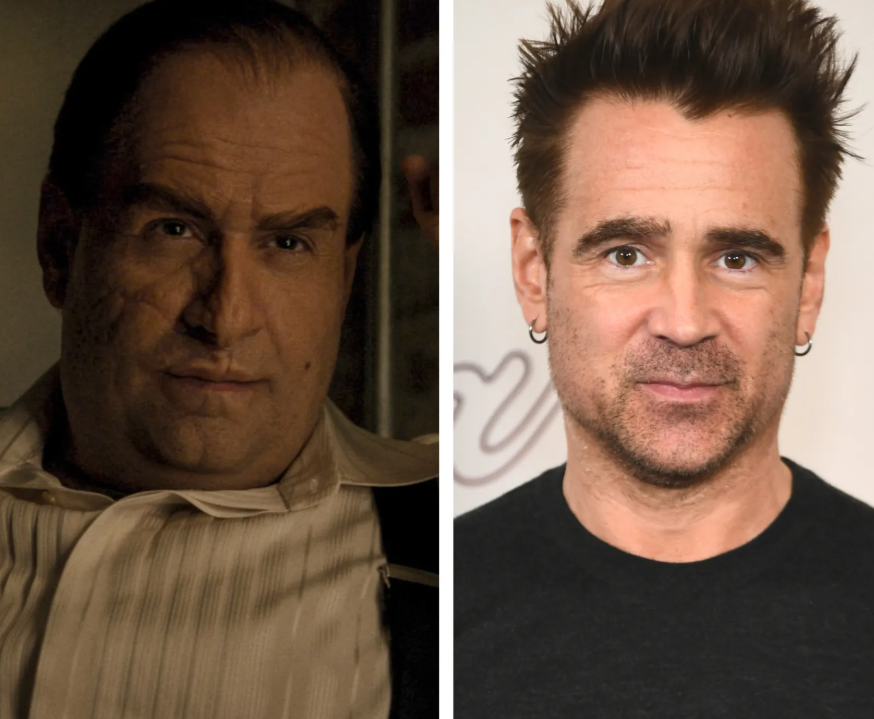In the world of cinema, actors often undergo remarkable transformations to authentically portray their characters. These metamorphoses can involve significant physical alterations, intensive training, and the adoption of new mannerisms. Such dedication not only showcases their commitment to the craft but also enhances the storytelling experience for audiences.
Colin Farrell as The Penguin
Colin Farrell’s portrayal of Oswald Cobblepot, commonly known as The Penguin, in the HBO Max series “The Penguin” is a testament to his transformative acting abilities. Initially hesitant about taking on the role, Farrell was eventually convinced by the compelling script and the vision of the show’s executive producer, Matt Reeves. To embody the character, Farrell collaborated with makeup prosthetic designer Mike Marino. Marino crafted a detailed 360-degree bust of The Penguin, featuring a prominent facial scar and an elongated nose reminiscent of a beak. Farrell described his reaction to the design, stating, “I looked at the character, and I just saw history, and I saw pain, and I saw aggression, and I saw cruelty, and I saw a bit of sadness. And it was all there.” The daily transformation process required Farrell to spend three hours in the makeup chair, where his hair was flattened, and a meticulously sculpted and painted bald cap was applied to achieve the desired look.

Demi Moore in “G.I. Jane”
In the 1997 film “G.I. Jane,” Demi Moore delivered a powerful performance as Lieutenant Jordan O’Neil, the first woman to undergo training in the U.S. Navy SEALs program. To authentically depict the physicality and resilience required for the role, Moore underwent rigorous training, including grueling workouts and combat drills. One of the most notable aspects of her transformation was shaving her head, a bold move that symbolized her character’s commitment and determination to succeed in a male-dominated environment. Moore’s dedication to the role was evident in her portrayal, capturing the intense challenges and perseverance of her character.
Nicolas Cage in “Leaving Las Vegas”
Nicolas Cage’s role as Ben Sanderson, a suicidal alcoholic in the 1995 film “Leaving Las Vegas,” required a profound emotional and physical transformation. To prepare for the part, Cage immersed himself in the world of alcoholism, spending time with real-life alcoholics to understand their behaviors and struggles. He also recorded himself intoxicated to study his speech patterns and physical movements. This method approach allowed Cage to deliver a raw and authentic performance, capturing the despair and vulnerability of his character. His commitment to the role earned him critical acclaim, including an Academy Award for Best Actor.
Christian Bale in “The Machinist”
Christian Bale is renowned for his extreme physical transformations, and his role in the 2004 film “The Machinist” is a prime example. To portray Trevor Reznik, a factory worker suffering from severe insomnia and psychological distress, Bale underwent a drastic weight loss regimen. He reportedly lost over 60 pounds, reducing his weight to around 120 pounds, by following a strict diet and exercise routine. Bale’s emaciated appearance added a haunting realism to the character, effectively conveying the toll of insomnia and guilt on Reznik’s mind and body. His dedication to the role demonstrated an unwavering commitment to authenticity, even at the expense of his own health.
Charlize Theron in “Monster”
In the 2003 film “Monster,” Charlize Theron underwent a remarkable transformation to portray Aileen Wuornos, a real-life serial killer. To accurately depict Wuornos, Theron gained weight, wore prosthetic teeth, and underwent extensive makeup sessions to alter her appearance. She also studied Wuornos’s mannerisms and speech patterns to deliver an authentic performance. Theron’s portrayal was lauded for its depth and realism, earning her an Academy Award for Best Actress. Her willingness to completely immerse herself in the character showcased her dedication to the craft and her ability to tackle challenging roles.

These examples highlight the lengths to which actors will go to bring their characters to life. Through physical transformations, intensive training, and deep psychological immersion, they enhance the storytelling experience and leave lasting impressions on audiences. Such dedication underscores the artistry involved in acting and the profound impact it can have on cinema.

















